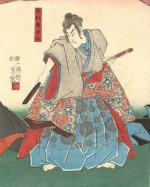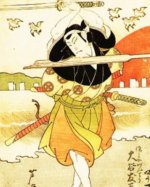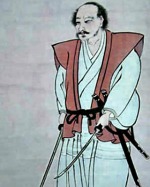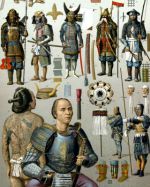The Azuchi-Momoyama Period
Talk the Talk
The Azuchi-Momoyama Period takes its name from the castles of the two most powerful warlords of the era.
One, belonging to Nobunaga Oda, was Azuchi Castle situated in the town of Azuchi in the Shiga Prefecture.
The other was Hideyoshi Toyotomi’s Momoyama Castle, also known as Fushimi (Peach Hill) Castle, which was located in the capital city of Heian-Kyo (modern day Kyoto).
Contemporaries of Nobunaga and Hideyoshi referred to it as the Tensho Period, and it is still sometimes called this today.
It is also sometimes known as the Shokuho Period, after the centralised governmental system that emerged in Japan at the time, or the Azuchi-Osaka Period, as Osaka was the location where Hideyoshi built his castle.
Walk the Walk
Hideyoshi Toyotomi was of low birth but managed to work his way up the social ranks through his prowess on the battlefield, becoming one of Nobunaga Oda’s most trusted generals.
After Nobunaga’s death, he secured himself as the most powerful man in Japan and was adopted by the Fujiwara Clan, one of the oldest noble families in the country and relatives of the emperor.
Although the Imperial ruler had no real power, Hideyoshi gave him money for official ceremonies and to help rebuild his palace in the capital in a bid to win his favour and to legitimise his own rule.
Known initially as Hideyoshi Hashiba, the emperor gave him the new, more noble family name Toyotomi.
He took the rank and titles of Kampaku (Imperial Regent), the first low born person to ever to hold the rank, and Daijo-daijin (Chancellor of the Realm), the highest official position and title available to the ruling elite besides for shogun, a title he was never able to secure due to his peasant origins.
broke the law.
Samurai History Fact
The start date given for the Azuchi-Momoyama Period varies among historians and many claim that it began in 1568, when Nobunaga Oda first took control of Kyoto.
Others use
the starting date of 1573, when Nobunaga took sole control of the capital city, while others still give the date as 1576, when construction of Azuchi Castle began.
The date the period ended is also a point of contention as some argue that the most appropriate date to use is 1598 which was when Hideyoshi Toyotomi died.
Some say it should be 1600 when
Ieyasu Tokugawa won the Battle of Sekigahara and others still maintain that 1603 is probably the best year to end the Azuchi-Momoyama Period and begin the Edo Period as it was when Ieyasu established his government base in Edo.
The Azuchi-Momoyama Period (c.1568 – c.1603) is significant because it saw Japan become unified, after centuries of disjointed warlords (daimyo) ruling their own territories. While a central government existed during the preceding years, known as the Muromachi Period, it was weak and ineffectual, and daimyo would often fight against each other in an attempt to expand their holdings.
Nobunaga Oda – The First Great Unifier of Japan
One such warlord was Nobunaga Oda (1534 – 1582), who had grown in power through the 1550s and 1560s not only through victory on the battlefield, but also through diplomacy. He took the capital city of Heian-Kyo, along with the last Ashikaga shogun, Yoshiaki Ashikaga, in 1568. Once in power, he set about reducing the strength of other daimyo and used various methods to achieve this.
He gave lands to his allies to govern in his name but ensured that this took them away from their traditional power base. He also abolished tolls on roads to limit the income of his potential rivals. To boost his own income, he minted the first new currency since 958 CE and standardised the exchange rate. He also ended merchant guilds and ordered them to pay a state fee in place of guild membership fees, and from 1571, made the tax system more efficient, thereby further increasing his revenue.
In addition, he unsurprisingly destroyed the power bases of rival daimyo, and also targeted Buddhist monasteries. In 1571, he destroyed the Enryakuji monastic complex on the sacred Mt. Hiei near Kyoto, killing 25,000 men, women, and children in the process. He did, however, encourage Christian missionaries to work in Japan as he believed that links with Europeans would bring trade and innovative technologies to the country.
Nobunaga Oda – Sole Ruler of Japan
After political and philosophical differences had caused a rift between him and Yoshiaki Ashikaga, he exiled the shogun in 1573. Nobunaga was keen to completely unite the country under his rule and by taking control of the capital, he had put himself in a position to do just that although he would spend most of his reign consolidating his power and bringing rebel clans to order.
Two of the early threats to Nobunaga’s rule were Shingen Takeda and Kenshin Uesugi. Both led powerful clans but died before they had a chance to do battle with him.
However, the Takeda Clan did fight against him at the Battle of Nagashino in 1575, but were defeated, primarily due to his use of modern warfare, particularly the use of firearms. His armies contained 3,000 musketeers who would employ the rolling volley fire tactic to create a continuous torrent of shots at his enemies. He was also the first to ensure his infantry had full armour, making them harder to kill than their opposing numbers. Between 1576 and 1579, Nobunaga constructed his magnificent seven-story Azuchi Castle, which served as his residence, an impregnable military fortress, and a symbol of Japan's unification.
The Death of Nobunaga Oda
While he was away from his castle and staying in Heian-Kyo with only a small retinue in 1582, one of his disgruntled generals, Mitsuhide Akechi, murdered him in what became known as the Honnoji Incident. By the time of his death, Nobunaga Oda controlled much of Japan and was on the verge of achieving his goal of unifying the archipelago.
Sources differ on exactly how he died. Some have it that he committed ritual suicide (seppuku) before his enemy could capture him while another version of events states that he was, along with his heir Nobutada, killed in the flames as the temple he occupied, the Temple of Honnoji, burned to the ground (depicted above). However it happened, the Oda Clan was left with no clear successor, which threatened the country with more disorder and a return to civil war.
Hideyoshi Toyotomi – The Second Great Unifier of Japan
Revenge for the death of Nobunaga was swift, and Mitsuhide was defeated by one of Nobunaga’s top generals, Hideyoshi Toyotomi (1537 – 1598), at the Battle of Yamazaki, less than two weeks after the death of his master. At first, Hideyoshi was named co-guardian of Nobunaga’s infant grandson Sanposhi who became head of the Oda Clan. However, after some political intrigue followed by some open confrontation with other leading generals, Hideyoshi managed to take control of all the holdings once owned by his former daimyo, leaving him as the ruler of much of Japan from 1582.
Hideyoshi picked up where Nobunaga had left off and continued to work to unify the country. In 1583, he managed to subdue the Northern Provinces and the island of Shikoku. By 1585, three of the nine daimyo coalitions were paying tribute to him, and in 1587, he brought Kyushu under his control.
In 1590, he led an army reportedly comprising of 200,000 men and defeated his last major rivals, the Hojo Clan, in Odawara. After this, any remaining daimyo soon fell into order, and Hideyoshi had finally achieved his goal and united all the clans of Japan under his rule. In a bid to consolidate his power, Hideyoshi destroyed many castles throughout the country while completing the construction of his own, Osaka Castle, in 1590.
Japanese Society under Hideyoshi Toyotomi
In 1588, he instigated new rules of social order for those under his dominion, when he forbade members of the samurai class from engaging in farming and compelled them to relocate to castle towns. Furthermore, towns and cities were divided into districts with some housing those of higher social rank and other areas designated for the lower orders.
In the same year, he also instigated the katanagari (Sword Hunt), whereby he confiscated the weapons of farmers, religious institutions and anybody not belonging to the military. They were then melted down and turned into nails and brackets that would hold together a giant wooden statue of the Buddha.
The temple that housed the statue was approximately fifteen stories high and was likely the largest wooden building on the planet at that time. It took tens of thousands of men five years to complete the statue, but not long after it was finished, the 1596 earthquake collapsed the temple's roof, destroying the statue beneath it. In a rage, Hideyoshi is reported to have shot the remains of the statue with an arrow and shouted, “I put you here at great expense and you can’t even look after your own temple.”
Despite his own meteoric rise in social class, he took even more measures to effectively freeze class distinctions in Japan in 1591, making social movement virtually impossible. He brought in a rigid class system called the shi-no-ko-sho system which consisted of, warriors (shi), farmers (no), artisans (ko) and merchants (sho).
Boys would adopt the role of their fathers, so a farmer’s son would become a farmer and only the sons of samurai could become members of the warrior class. This also meant that samurai could not make a living in any other way, so they were totally dependent on their feudal lord to provide an income for them. This system remained in place throughout the Azuchi-Momoyama Period and continued until the end of the Edo Period in 1868.
Although many had accepted Christianity when it first arrived in Japan in the 1540s, Hideyoshi Toyotomi took a dim view of the new religion and decided to expel some of its members in 1587. He believed that Portuguese traders were taking Japanese citizens as slaves and some Jesuits were pushing for the persecution of priests from the native religions, Buddhism and Shintoism. The expulsion was not actually enforced much until 1597, when twenty-six Christians were mutilated and crucified in Nagasaki, leading to them becoming known as the Nagasaki Martyrs (depicted below). After this, the law against Christianity was not particularly enforced again as a result of the lucrative trade he enjoyed with the Portuguese and other foreign nations.
Hideyoshi Toyotomi’s Invasion of Korea
After unifying Japan in 1590, Hideyoshi took his ambitions further and in 1592, he led an invasion force to Korea. When the army, which consisted of nearly 160,000 men, landed, it took the Koreans totally by surprise, forcing their king, Seonjo (r. 1567-1608 CE), to flee to the north. Firearms played a crucial role in their early victories, as cities like Pyongyang and Seoul fell to the Japanese within just a few weeks, though the Korean forces did rally and manage to limit the progress made. Hideyoshi would invade Korea again in 1597, the second in a pair of conflicts known as the Imjin Wars. This was less successful than the first attack and the following year after his death, the Japanese left Korea altogether.
The ultimate plan was first to conquer Korea and then use that as a base to wrest control of China from the Ming Dynasty (1368–1644), a plan so ambitious that some believe Hideyoshi may have been mentally unstable by this time. The conflict was the largest military operation in East Asia at the time and remained so until the twentieth century. It soured relations between Korea and Japan for generations to come and was so financially draining for the Ming Dynasty, that it played a part in its decline over the coming decades.
The End of the Azuchi-Momoyama Period
Hideyoshi Toyotomi died of natural causes on 18 September 1598, and was succeeded by Ieyasu Tokugawa, who had been a general in both his and Nobunaga Oda’s armies. While on his deathbed, Hideyoshi appointed a group of five lords to rule as the Council of Five Regents until his son and heir, Hideyori, came of age. However, they frequently fought amongst themselves, and when Ieyasu was accused of disloyalty to the Toyotomi name, a crisis arose that led to the Battle of Sekigahara. Tokugawa emerged victorious, leaving him in control of the country and marking the end of the Toyotomi Clan's reign. Soon after in 1603, he had himself named shogun, and would go on to become the Third Great Unifier of Japan. His victory would also bring an end to the Azuchi-Momoyama Period and usher in the Edo Period and the rule of the Tokugawa Shogunate.
Written by Andrew Griffiths – Last updated 18/08/2025. If you like
what you see, consider following the History of Fighting on social media.
Further Reading:
Azuchi-Momoyama Period. [Internet]. 2019. New World Encyclopedia. Available From: www.newworldencyclopedia.org/entry/Azuchi-Momoyama_period [Accessed 12 July 2025].
Azuchi-Momoyama Period (1573 – 1603). [Internet]. 2002. Japan Guide. Available From: www.japan-guide.com/e/e2123.html [Accessed 12 July 2025].
Cartwright, M. [Internet]. 2019. Azuchi-Momoyama Period. World History Encyclopedia. Available From: www.worldhistory.org/Azuchi-Momoyama_Period [Accessed 12 July 2025].
Hideyoshi – Built a Statue of Buddha That Crashed. [Internet]. 2025. Family Times. Available From: www.family-times.net/illustration/hideyoshi-built-a-statue-of-buddha-that-crashed-11455 [Accessed 12 July 2025].
Hoko-ji. [Internet]. 2025. Samurai Archives. Available From: https://samurai-archives.com/wiki/Hoko-ji [Accessed 12 July 2025].
Momoyama Period (1573 – 1615). 2002. The Metropolitan Museum of Art. Available From: www.metmuseum.org/essays/momoyama-period-1573-1615 [Accessed 12 July 2025].
More Samurai History
Samurai History Home
A brief overview of the history of the samurai, looking at the rise and development of the leading social class in Japan and some of the cultural traits than made the samurai warriors unique such as their weapons and their code of ethics, known as bushido.
A brief overview of the history of the samurai, looking at the rise and development of the leading social class in Japan and some of the cultural traits than made the samurai warriors unique such as their weapons and their code of ethics, known as bushido.
The Heian Period
The Heian Period was
a time of major change in Japan as it saw the rise of a new warrior elite, the Samurai. The leaders of this new power would dominate the politics of the country for
centuries and would even supplant the power of the Emperor, though not without a struggle.
Tomoe Gozen – Female Samurai Warrior
Tomoe Gozen is a rare example of a female Samurai warrior and is believed to have been involved in the Gempei wars (1180 – 1185). She fought alongside her Master, Minamoto Yoshinaka, though it is unclear how much of her story is actually true.
Tomoe Gozen is a rare example of a female Samurai warrior and is believed to have been involved in the Gempei wars (1180 – 1185). She fought alongside her Master, Minamoto Yoshinaka, though it is unclear how much of her story is actually true.
Yoshitsune Minamoto
The tragic tale of samurai legend Yoshitsune Minamoto. After helping his brother Yoritomo win the Genpei War and gain control of Japan, he was denied the titles and rewards he should have received for his services and was ultimately hunted down as a traitor.
The tragic tale of samurai legend Yoshitsune Minamoto. After helping his brother Yoritomo win the Genpei War and gain control of Japan, he was denied the titles and rewards he should have received for his services and was ultimately hunted down as a traitor.
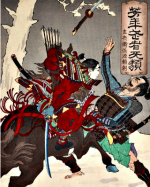
The Kamakura Period
A look at the change and turmoil experienced by the ruling elite of Japan during the Kamakura Period and the Kemmu Restoration. A series of civil wars and two invasions from the Mongols saw powershifts not only between rival families, but also between the titles of the Emperor, the Shogun and the Regent.
A look at the change and turmoil experienced by the ruling elite of Japan during the Kamakura Period and the Kemmu Restoration. A series of civil wars and two invasions from the Mongols saw powershifts not only between rival families, but also between the titles of the Emperor, the Shogun and the Regent.
The Mongols vs. The Samurai
While the samurai warriors of the late thirteenth century were formidable warriors in their own right, when faced with the onslaught of the Mongol Hordes they seemed to be fated to lose. They were outclassed in every way by however things did not go according to plan for the foreign invaders.
While the samurai warriors of the late thirteenth century were formidable warriors in their own right, when faced with the onslaught of the Mongol Hordes they seemed to be fated to lose. They were outclassed in every way by however things did not go according to plan for the foreign invaders.
The Japanese Samurai Sword
The samurai sword, it is said, was believed to contain the soul of the warrior who owned it. While this is probably an over romanticised view, it is true to say that there was a spiritual connection not only for the wielder of the katana, but also for the sword smith and his creation.
The samurai sword, it is said, was believed to contain the soul of the warrior who owned it. While this is probably an over romanticised view, it is true to say that there was a spiritual connection not only for the wielder of the katana, but also for the sword smith and his creation.
The Muromachi Period
The Muromachi Period was a time of turmoil in Japan that can be spilt into two separate eras. At the beginning of the period, the government was divided into two separate entities sparking the Northern and Southern Courts Era. Then, after a brief period of relative stability, the Warring States Era began.
Tsukahara Bokuden
Tsukahara Bokuden was a samurai warrior who lived in the 16th century. In his early days he exemplified what a samurai should be and was known as one of the fiercest warriors around. However in later life, Bokuden would take on a more pacifist philosophical stand point.
Tsukahara Bokuden was a samurai warrior who lived in the 16th century. In his early days he exemplified what a samurai should be and was known as one of the fiercest warriors around. However in later life, Bokuden would take on a more pacifist philosophical stand point.
The Death of a Samurai
The manner in which a samurai died was very important and if possible, it would be during combat in a way that would be told in samurai stories for years to come. Failing that, he should die in some other service to his lord or if his honour depended on it, in a ritualistic suicide known as seppuku.
The manner in which a samurai died was very important and if possible, it would be during combat in a way that would be told in samurai stories for years to come. Failing that, he should die in some other service to his lord or if his honour depended on it, in a ritualistic suicide known as seppuku.
The Duels of Miyamoto Musashi
Miyamoto Musashi is one of the most acclaimed samurai that ever lived. While undertaking a warrior’s pilgrimage, he fought in over 60 duels dispatching the best swordsmen in a given area, often in fights to the death.
The Samurai at War
The main business of the samurai was war and while tactics and weapons changed through the years, the willingness to die for their lord was a constant. In return, they could gain riches and status, as well as the best of them gaining a kind of immortality by having stories told about them for centuries to come.
The main business of the samurai was war and while tactics and weapons changed through the years, the willingness to die for their lord was a constant. In return, they could gain riches and status, as well as the best of them gaining a kind of immortality by having stories told about them for centuries to come.
The images on this site are believed to be in the public domain, however, if any mistakes have been made and your copyright or intellectual rights have been breeched, please contact andrew@articlesonhistory.com.

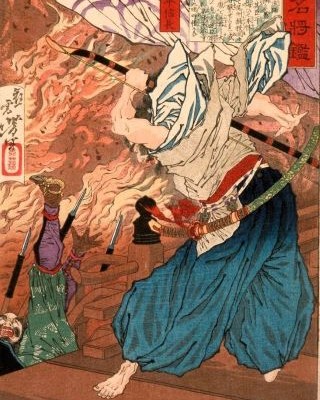
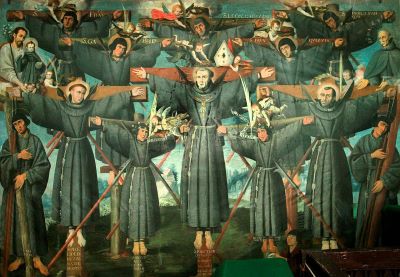
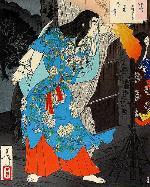
.jpg?timestamp=1581258471356)
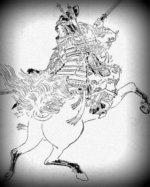
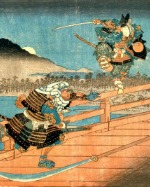
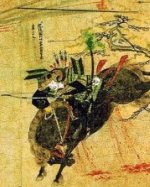
 thumb.jpg?timestamp=1581258911078)
